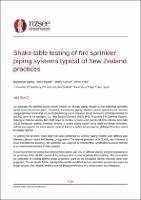| dc.contributor.author | Rashid, Muhammad | |
| dc.contributor.author | Dhakal, Rajesh | |
| dc.contributor.author | Sullivan, Timothy | |
| dc.contributor.author | Yeow, Trevor | |
| dc.date.accessioned | 2021-06-22T04:02:06Z | |
| dc.date.available | 2021-06-22T04:02:06Z | |
| dc.date.issued | 2021-04-14 | |
| dc.identifier.uri | https://repo.nzsee.org.nz/xmlui/handle/nzsee/2426 | |
| dc.description.abstract | An automatic fire sprinkler piping system requires an intricate piping network to feed individual sprinklers spread across the plenum space. In practice, this elaborate piping network is braced against seismic demands using proprietary braces that are installed following a set of empirical design provisions (primarily limiting the spacing) given in the standards; e.g. New Zealand Standard (NZS) 4541: Automatic Fire Sprinkler Systems. Relying on these provisions, NZS 4541 requires sprinkler systems to be operational at the ultimate limit state (ULS) earthquake loading. However, bracing a random piping system using empirical design provisions, without any regard to the actual seismic demand, leads to a system whose expected global performance cannot be reliably defined.
To address this problem, shake table tests were performed on sprinkler piping systems with different pipe diameters, plenum depths and bracing configurations. The seismic provisions of NZS 4541 were followed to brace and detail the specimen. The specimen was subjected to recorded floor acceleration response histories of an instrumented building in New Zealand.
It was found from the testing that different floor motions can lead to different seismic demands depending on the proximity of the vibration period of the piping system to a modal period of the building. This necessitates the calibration of existing seismic design provisions based on the anticipated seismic demands rather than judgement. The test results further highlight the need for simplified demand estimation procedures to make the design process more reliable, and the expected global performance of a piping system less ambiguous. | |
| dc.language.iso | en | |
| dc.publisher | New Zealand Society for Earthquake Engineering | |
| dc.relation.ispartofseries | 2021;0101 | |
| dc.relation.replaces | Engineering assessments for general purposes and potentially earthquake-prone buildings | |
| dc.relation.replaces | Innovative approaches in seismic design and assessment | |
| dc.subject | Advancements in structural and geotechnical design and assessment | |
| dc.title | Shake table testing of fire sprinkler piping systems typical of New Zealand practices | |
| dc.type | Article | |

